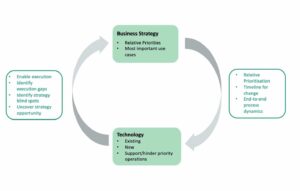The Decision to Change (or not)
In an increasingly dynamic business environment, organisations are compelled to question whether their existing IT systems can support their business strategy going forward. This is often a major pivot point: a choice between upgrading or enhancing that existing technology, or supporting larger-scale IT overhaul. The complexity of this decision, however, can be enormous. When technology is embedded, all business stakeholders can be affected. Yet businesses often lack a clear structure to approach decisions from both a technology and a business strategy perspective.
Through operating a continuous feedback loop to inform decisions, both technology and business strategy can be optimised to reach their true potential. In this article, we’ll explore how the feedback loop works, and what factors decision makers need to consider in order to make technology decisions more successfully.
What is the Strategy – Technology Feedback Loop?
Like any other business decision, large-scale technology choices must first be informed by the business strategy. Without that guidance, technology runs the risk of becoming an end unto itself, rather than serving the needs of the business. It is crucial, however, to also acknowledge the role of technology in asking questions of the business strategy. Just as implementing a software robot can find ‘gaps’ in the process it was deployed to complete, so too can technology determine where business strategy falls short. This applies whether businesses decide to implement new technology or retain legacy systems. Without this two-way exchange of data and accountability, both business strategy and technology employed fail to reach their potential.

Figure 1: The Strategy – Technology Feedback Loop
This feedback loop is a simplified version of the OODA Loop (Observe-Orient-Decide-Act), a cycle designed for situations where quick and efficient decision making is required in response to unfolding events and new information. Native or transitioning digital businesses need feedback cycles like this to enable faster and more adaptive decision-making, now more than ever.
1. Using the Business Strategy to Determine Priorities
With the business strategy as a roadmap, decision makers must first determine the business priorities. What are the different operations of the business? Which of these are more important to meet business objectives? Many businesses have had to reassess this in the wake of COVID-19, and this has led to the hard realisation that relative, point-in-time decisions are required. No one part of the business is necessarily the only area needing investment (just as no one technology will be the perfect solution). Relative priority becomes key.
For example, when one of our recent clients needed to decide whether to upgrade their integration technology, they engaged us to help determine where their priorities lay. We utilised a structured methodology to help determine which integration patterns were required for each business unit and their order of priority. The table below demonstrates the demand for different types of integration (API-led vs IoT etc.) across the Client’s different business units.
2. Using Priorities, Assess Technology
Armed with business strategy and an understanding of priorities, decision makers can then assess technology. A decision point of this kind must ask questions of not only legacy systems, but also any potential new solutions.
A legacy system may have served the organisation well up to this point. The key here is to ask the extent to which the current technology services future business needs. Looking at the priority use cases, decision-makers need to ask:
- What core functionality / maturity is required for candidate technologies to meet the prioritised needs?
- To what extent are the technologies customisable and scalable, and is this is even required to support the business strategy?
- How current is the legacy system? Is it at end of support? An upgrade can be as disruptive as a replacement.
At this point, a ranking of the options – based on their ability to service the priorities – will present the organisation with a choice. Invariably this may include legacy upgrade, augmentation, hybrid or replacement. This is a key pivot point for the business.
3. Closing the Feedback Loop
It is at this point that many technology decisions are made. However, this is also the moment where a perfect opportunity to improve business strategy can be missed or realised.
To close the feedback loop, it is critical that the shortlisted options ask questions of the business and strategy in return, to uncover issues or opportunity ahead of time.
- What strategy elements could be re-considered due to a better appreciation for technology capability?
- How can the technology throttle the execution of the strategy?
- What ways of working/business culture will need to change?
- What are the skills/resources required to support this technology?
- Are there cultural/employee buy-in factors?
In recent engagements we have leveraged this feedback loop to bring more clarity and ambition to clients’ digital strategy, based on a better understanding of fundamental technology capability. Undertaking this step allows an organisation to ‘Orient’ itself as it moves into a transformative phase.
Change Management: Don’t Underplay Implementation
As the term implies, this pivot point is the start of a new phase. The decision has been made, but the hard work has just begun. Even for the best-made decisions, it is important not to underplay or underinvest in implementation. Successful implementation is best achieved by starting change management early and continuing the feedback loop process. The decision to change is not static, and must be accountable to the intended outcome in a dynamic and challenging environment.
The steps presented here, though basic, exist in more fully-formed methodologies that we have used successfully with various clients. To learn more about optimising the strategy- technology feedback loop for digital transformation, feel free to contact us here.



